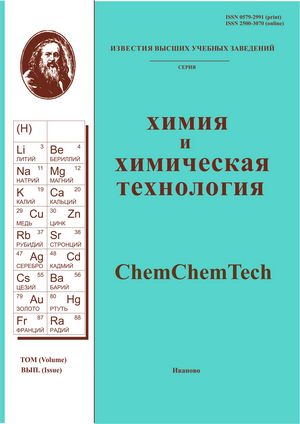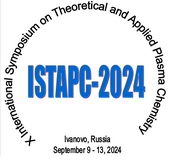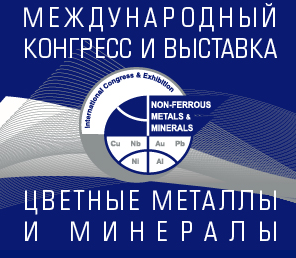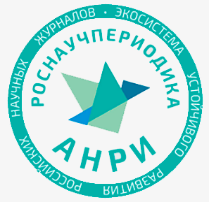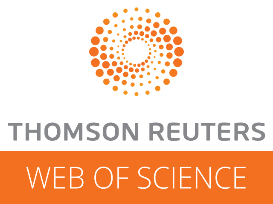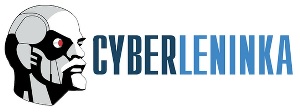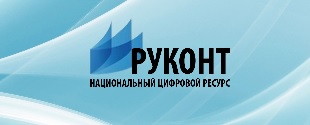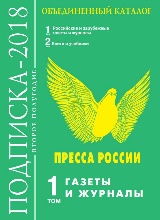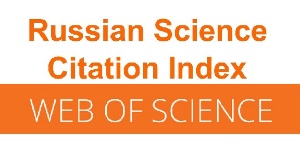О ВЛИЯНИИ ИНЕРТНОГО ГАЗА-НОСИТЕЛЯ НА КОНЦЕНТРАЦИИ АКТИВНЫХ ЧАСТИЦ И КИНЕТИКУ ТРАВЛЕНИЯ ZrO2 В ПЛАЗМЕ ХЛОРА
Аннотация
Исследовано влияние вида и содержания инертного газа-носителя на электрофизические параметры плазмы хлора, стационарные концентрации активных частиц и кинетику их взаимодействия с ZrO2 в условиях “мягкого” реактивно-ионного травления. Данный режим предполагает использование более низкого, чем обычно, отрицательного смещения для снижения энергии ионной бомбардировки и дефектообразования на обрабатываемой поверхности. При совместном использовании диагностики плазмы с помощью зондов Ленгмюра и 0-мерного моделирования плазмы проведен анализ кинетики процессов образования и гибели активных частиц в смесях переменного начального состава. Найдено, что добавка к хлору Ar или He при постоянном общем давлении смеси a) способствует увеличению температуры и концентрации электронов; б) вызывает рост степени диссоциации молекул Cl2 за счет ускорения процессов под действием электронного удара; и в) интенсифицирует ионную бомбардировку за счет изменения плотности потока ионов. Эксперименты показали, что скорость травления ZrO2 определяется, в основном, химической составляющей, но не коррелирует с изменением плотности потока атомов хлора. Такая ситуация означает, что а) доминирующим механизмом травления ZrO2 является ионно-стимулированная химическая реакция и б) увеличение эффективной вероятности этой реакции в смесях с высоким содержанием Ar или He отражает ускорение ионно-индуцированных гетерогенных эффектов, таких как разрушение связей Zr-O и/или десорбция слаболетучих соединений ZrClx. Более низкое отношение плотностей потоков нейтральных и заряженных частиц, наблюдаемое при разбавлении хлора аргоном, позволяет предположить более анизотропное травление. Показано, что отмеченные особенности уверенно сохраняются в диапазоне давлений 4–12 мтор и мощностей смещения 100–300 Вт.
Для цитирования:
Ефремов А.М., Смирнов С.А., Бетелин В.Б., Kwon K.-H. О влиянии инертного газа-носителя на концентрации активных частиц и кинетику травления ZrO2 в плазме хлора. Изв. вузов. Химия и хим. технология. 2024. Т. 67. Вып. 11. С. 40-54. DOI: 10.6060/ivkkt.20246711.7073.
Литература
Nojiri K. Dry etching technology for semiconductors. Tokyo: Springer Internat. Publ. 2015. 116 p. DOI: 10.1007/978-3-319-10295-5.
Advanced plasma processing technology. New York: John Wiley & Sons Inc. 2008. 479 p.
Wolf S., Tauber R.N. Silicon Processing for the VLSI Era. Volume 1. Process Technology. New York: Lattice Press. 2000. 416 p.
Donnelly V. M., Kornblit A. Plasma etching: Yesterday, today, and tomorrow. J. Vac. Sci. Technol. 2013. V. 31. P. 050825-48. DOI: 10.1116/1.4819316.
Lieberman M.A., Lichtenberg A.J. Principles of plasma discharges and materials processing. New York: John Wiley & Sons Inc. 2005. 757 p. DOI: 10.1002/0471724254.
Kemaneci E.H., Carbone E.A.D., Booth J.P., Graef W.A.A.D., Dijk van J., Kroesen G.M.W. Global (volume-averaged) model of inductively coupled chlorine plasma : influence of Cl wall recombination and external heating on continuous and pulse-modulated plasmas. Plasma Sources Sci. Technol. 2014. V. 23(4). P. 045002(1-14). DOI: 10.1088/0963-0252/23/4/045002.
Efremov A., Lee J., Kwon K.-H. A comparative study of CF4, Cl2 and HBr + Ar inductively coupled plasmas for dry etching applications. Thin Solid Films. 2017. V. 629. P. 39-48. DOI: 10.1016/j.tsf.2017.03.035.
Malyshev M.V., Donnelly V.M. Diagnostics of chlorine inductively coupled plasmas. Measurement of electron temperatures and electron energy distribution functions. J. Appl. Phys. 2000. V. 87. P. 1642-1650. DOI: 10.1063/1.372072.
Thorsteinsson E.G., Gudmundsson J.T. A global (volume averaged) model of a chlorine discharge. Plasma Sources Sci. Technol. 2010. V. 19. P. 015001 (1-15). DOI: 10.1088/0963-0252/19/1/015001.
Efremov A.M., Kim G.H., Kim J.G., Bogomolov A.V., Kim C.I. Applicability of self-consistent global model for characterization of inductively coupled Cl2 plasma. Vacuum. 2007. V. 81. N 5. P. 669-675. DOI: 10.1016/j.vacuum.2006.09.017.
Tinck S., Boullart W., Bogaerts A. Simulation of an Ar/Cl2 inductively coupled plasma: study of the effect of bias, power and pressure and comparison with experiments. J. Phys. D. Appl. Phys. 2008. V. 41. N 18. P. 065207. DOI: 10.1088/0022-3727/41/6/065207.
CRC Handbook of Chemistry and Physics. New York: CRC Press. 2010. 2760 p.
Kol S., Oral A.Y. Hf - based high-k dielectrics: A Review. Acta Physica Polonica A. 2019. V. 136(6) P. 873-881. DOI: 10.12693/APhysPolA.136.873.
Clark R.D. Emerging Applications for High-K Materials in VLSI Technology. Materials. 2014. V. 7(4). P. 2913-2944. DOI: 10.3390/ma7042913.
Kim M., Min N.-K., Yun S.J., Lee H.W., Efremov A., Kwon K.-H. On the etching mechanism of ZrO2 thin films in inductively coupled BCl3/Ar plasma. Microelectronic Eng. 2008. V. 85(2). P. 348-354. DOI: 10.1016/j.mee.2007.07.009.
Lee C.-I., Kim G.-H., Kim D.-P., Woo J.-C., Kim C.-I. Dry etching mechanisms of ZrO2 thin films in BCl3/Cl2/Ar plasma. Ferroelectrics. 2009. V. 384(1). P. 32-38. DOI: 10.1080/00150190902892725.
Woo J.-C., Yang X., Um D.-S., Kim C.-I. Dry etching characteristics of ZrO2 thin films using high density Cl2/Ar plasma. Ferroelectrics. 2010. V. 407(1). P. 117-124. DOI: 10.1080/00150193.2010.484750.
Sha L., Cho B.-O., Chang J. P. Ion-enhanced chemical etching of ZrO2 in a chlorine discharge. J. Vac. Sci. Tech-nol. A. 2002. V. 20(5). P. 1525-1531. DOI: 10.1116/1.1491267.
Efremov A., Min N.-K., Yun S. J., Kwon K.-H. Effect of gas mixing ratio on etch behavior of ZrO2 thin films in Cl2 -based inductively coupled plasmas. J. Vac. Sci. Technol. A. 2008. V. 26(6). P. 1480-1486. DOI: 10.1116/1.2998806.
Efremov A.M., Murin D.B., Betelin V.B., Kwon K.-H. Special Aspects of the Kinetics of Reactive Ion Etching of SiO2 in Fluorine-, Chlorine-, and Bromine-Containing Plasma. Russian Microelectronics. 2020. V. 49. N 2. P. 94-102. DOI: 10.1134/S1063739720010060.
Shun’ko E.V. Langmuir probe in theory and practice. Boca Raton: Universal Publ. 2008. 245 p.
Engeln R., Klarenaar B., Guaitella O. Foundations of optical diagnostics in low-temperature plasmas. Plasma Sources Sci. Technol. 2020. V. 29. P. 063001(1-14). DOI: 10.1088/1361-6595/ab6880.
Lopaev D.V., Volynets A.V., Zyryanov S.M., Zotovich A.I., Rakhimov A.T. Actinometry of O, N and F atoms. J. Phys. D: Appl. Phys. 2017. V. 50. P. 075202(1-17). DOI: 10.1088/1361-6463/50/7/075202.
Richards A.D., Thompson B.E., Allen K.D., Sawin H.H. Atomic chlorine concentration measurements in a plasma etching reactor. I. A comparison of infrared absorption and optical emission actinometry. J. Appl. Phys. 1987. V. 62(3). P. 792-279. DOI: 10.1063/1.339734.
Hanish C.K., Grizzle J.W., Teny F.L. Estimating and controlling atomic chlorine concentration via actinometry. IEEE Trans. Semicond. Manufact. 1999. V. 12(3). P. 323-331. DOI: 10.1109/66.778197.
Fuller N., Herman I., Donnelly V. Optical actinometry of Cl2, Cl, Cl+, and Ar+ densities in inductively coupled Cl2-Ar plasmas. J. Appl. Phys. 2001. V. 90. P. 182-3191. DOI: 10.1063/1.1391222.
Malyshev M.V., Donnelly V.M., Kornblit A., Ciampa N.A. Percent dissociation of Cl2 in inductively coupled chlorine-containing plasmas. J. Appl. Phys. 1998. V. 84(1). P. 137-146. DOI: 10.1063/1.368010.
Malyshev M.V., Donnelly V.M., Diagnostics of inductively coupled chlorine plasmas: Measurement of Cl2 and Cl number densities. J. Appl. Phys. 2000. V. 88(11). P. 6207-6215. DOI: 10.1063/1.1321777.
Hsu C. C., Nierode M. A., Coburn J. W., Graves D. B. Comparison of model and experiment for Ar, Ar/O2 and Ar/O2/Cl2 inductively coupled plasmas. J. Phys. D. Appl. Phys. 2006. V. 39. P. 3272-3284. DOI: 10.1088/0022-3727/39/15/009.
Huang S., Gudmundsson J. A particle-in-cell/Monte Carlo simulation of a capacitively coupled chlorine discharge. Plasma Sources Sci. Technol. 2013. V. 22. P. 055020(1-16). DOI: 10.1088/0963-0252/22/5/055020.
Mione M. A., Katsouras I., Creyghton Y., Boekel W., Maas J., Gelinck G., Roozeboom F., Illiberi A., Atmos-pheric Pressure Plasma Enhanced Spatial ALD of ZrO2 for Low-Temperature, Large-Area Applications. J. Solid State Sci. Technol. 2017. V. 6(12). P. N243-N249. DOI: 10.1149/2.0381712jss.
Efremov A.M., Kim G.H., Kim J.G., Bogomolov A.V., Kim C.I. On the applicability of self-consistent global model for the characterization of Cl2/Ar inductively coupled plasma. Microelectron. Eng. 2007. V. 84. P.136-143. DOI: 10.1016/j.mee.2006.09.020.
Efremov A.M., Kim D.P., Kim C.I. Simple model for ion-assisted etching using Cl2-Ar inductively coupled plasma: Effect of gas mixing ratio. IEEE Trans. Plasma Sci. 2004. V. 32. N 3. P. 1344-1351. DOI: 10.1109/TPS.2004.828413.
Meeks E., Ho P., Ting A., Buss R.J. Simulations of BCl3/Cl2/Ar plasmas with comparisons to diagnostic data. J. Vac. Sci. Technol. A. 1998. V. 16. P. 2227-2239. DOI: 10.1116/1.581332.
Corr C.S., Despiau-Pujo E., Chabert P., Graham W.G., Marro F.G., Graves D.B. Comparison between fluid simulations and experiments in inductively coupled argon/chlorine plasmas. J. Phys. D. Appl. Phys. 2008. V. 41(18). P. 185-202. DOI: 10.1088/0022-3727/41/18/185202.
Gray D.C., Tepermeister I., Sawin H.H. Phenomenological modeling of ion enhanced surface kinetics in fluorine-based plasma etching. J. Vac. Sci. Technol. B. 1993. V. 11. P. 1243-1257. DOI: 10.1116/1.586925.
Vitale S.A., Chae H., Sawin H. H. Silicon etching yields in F2, Cl2, Br2, and HBr high density plasmas. J. Vac. Sci. Technol. 2001. V. 19. P. 2197-2206. DOI: 10.1116/1.1378077.
Efremov A.M., Smirnov S.A., Betelin V.B., Kwon K.-H. On the comparison of reactive-ion etching mechanisms for SiO2 in fluorine- and chlorine-containing plasmas. ChemChemTech [Izv. Vyssh. Uchebn. Zaved. Khim. Khim. Tekhnol.]. 2023. V. 66. N 8. P. 52-64.
Seah M.P., Nunney T.S. Sputtering yields of compounds using argon ions. J. Phys. D: Appl. Phys. 2010. V. 43 P. 253001 (1-24). DOI: 10.1088/0022-3727/43/25/253001.
Raju G.G., Gaseous electronics. Tables, Atoms and Molecules. Boca Raton: CRC Press. 2012. 790 p. DOI: 10.1201/b11492.
Christophorou L.G., Olthoff J.K. Fundamental electron interactions with plasma processing gases. New York: Springer Science+Business Media LLC. 2004. 776 p. DOI: 10.1007/978-1-4419-8971-0.
Kota G.P., Coburn J.W., Graves D.B. The recombination of chlorine atoms at surfaces. J. Vac. Sci. Tech. A. 1998. V. 16(1). P. 270-277. DOI: 10.1116/1.580982.
Stafford L., Guha J., Khare R., Mattei S., Boudreault O., Clain B., Donnelly V.M. Experimental and modeling study of O and Cl atoms surface recombination reactions in O2 and Cl2 plasmas. Pure Appl. Chem. 2010. V. 82(6). P. 1301-1315. DOI: 10.1351/PAC-CON-09-11-02
Efremov A.M., Betelin V.B., Mednikov K.A., Kwon K.-H. Plasma parameters and densities of active species in mixtures of fluorocarbon gases with argon and oxygen. ChemChemTech [Izv. Vyssh. Uchebn. Zaved. Khim. Khim. Tekhnol.]. 2021. V. 64. N 7. P. 46-53.

